Abstract
Introduction: Since Gagarin became the first human to travel into space and complete one orbit around the Earth, on 12 April 1961, the number of manned spaceflights has increased significantly. Spaceflight is still complex and has potential risk for incidents and accidents. The aim of this study was to analyze how safe it is for humans to travel in space. Objectives: This paper, therefore, summarizes incidents and accidents covering the six decades of manned spaceflight (1961–2020). Material and methods: Extensive PubMed, Cochrane, and Google Scholar searches were made with search strings of “incidents”, “accident”, “spaceflight”, and “orbit”, and including all vehicles so far. Search terms were combined by AND or OR in search strings. Of the results obtained, studies which evaluated manned spaceflight were included in the study. Data from the National Aeronautics Space Agency (NASA), the Russian Space Agency (ROSCOSMOS), the European Space Agency (ESA), and the Chinese Space Agency (CNSA), as well as from the Virgin Galactic and the SpaceX databases, were searched to complete data and to identify all the accomplished manned spaceflights, as well as all incidents and accidents that have occurred in the specific period. Search results were compared to findings on Wikipedia, Encyclopedia Astronautica, and other public webpages. Reference lists of included articles/homepages were also included for further potential data. Results: From 1961–2020, our data revealed an increasing number of manned space flights, n = 327. The number of times an astronaut has been sent to space, n = 1294, resulted in an accumulated n = 19,414 days spent in space. The number of days spent in orbit has constantly increased from 1961 until today. The number of incidents (altogether n = 36) and accidents (altogether n = 5) has constantly decreased. The number of astronauts who have died during spaceflight is represented by n = 19. The current statistical fatality rate is 5.8% (deaths per spaceflight) with the highest fatality rate in the 1960s (0.013 deaths/day spent in space), and the lowest rates in the 1990s and the period from 2010 until the present (no deaths). The most dangerous phases of spaceflight are launch, landing and staying in orbit. Altogether, n = 12 incidents (incident rate per spaceflight: 0.04) and one accident (accident rate: 0.003) during launch have been reported, n = 9 incidents (incident rate: 0.03) and two accidents (accident rate: 0.006) have been reported during landing and n = 10 incidents (incident rate: 0.03) have been reported in orbit. Discussion: Manned spaceflight over the last six decades has become significantly safer. Since 2003, no astronaut fatality has been reported. With greater international cooperation and maintaining of the International Space Station (ISS), the number of manned spaceflights and days spent in space has constantly increased, with constantly lower rates of incidents and accidents.
1. Introduction
Human spaceflight has a successful history but with serious incidents and accidents, too. Since Yuri Gagarin’s first orbiting flight in 1961, mankind travelled to space for almost forty years before the implementation of the International Space Station (ISS). Project Mercury, the first U.S. program to put humans in space, made six successful flights into space with astronauts onboard between 1961 and 1963. The Gemini program primarily tested equipment and mission procedures and trained astronauts for future missions to the Moon. The Apollo 1 launchpad fire in 1967 was a tragic setback, but failed to deter mankind from reaching the Moon. Eight years after U.S. President Kennedy challenged Americans to reach for the Moon, Project Apollo landed the first humans on the lunar surface and returned them safely to Earth [1]. In 1973, Skylab expeditions paved the way for the International Space Station. In the 1970s, U.S.–Soviet political tensions amplified the space race [2].
After several decades of competition, the Apollo–Soyuz Test Project started in the mid-1970s [3]. International collaboration among many nations became standard during the Space Shuttle era and the International Space Station has resulted in the current cooperation in human spaceflight. In the past 30 years, NASA’s space shuttle fleet has conducted 135 missions and carried 355 different people into space, but with some fatalities. Tragically, NASA lost two crew members from a crew of seven in both the 1986 Challenger accident [4] and the 2003 Columbia accident [5]. Both events are remembered as deeply precipitous and, finally, led to a shutdown of the Shuttle Program.
Later, the first Chinese crewed space program began, culminating in Yang Liwei’s successful 2003 flight aboard Shenzhou 5 [6]. This achievement made China the third country to independently send humans into space. Plans currently include a permanent Chinese space station in 2022 and crewed expeditions to the Moon.
Since the end of the Space Race, spaceflight has been characterized by international cooperation and an expansion of private interests. The International Space Station, global cooperation and scientific advances have ushered in the growth of private industry in low-Earth orbit (LEO) and development of new technologies to advance different scientific fields. With the arrival of the Soyuz spacecraft on 2 November 2011, uninterrupted human presence in the orbiting laboratory commenced.
For nearly one decade, between the final flight of the Space Shuttle program in 2011 and the 2020 first crewed mission of SpaceX’s Falcon 9 rocket, Soyuz rockets were the only launch vehicles able to, and approved for, the transport of astronauts to the International Space Station. Future space missions strive to further explore the Moon [7] and Mars [8]. Commercial spaceflight is very much a part of future human space projects with, presumably, older people experiencing microgravity.
After 60 years of manned spaceflight, the question being asked is how safe legitimate travel into space is for mankind. The upcoming expeditions to the Moon and Mars represent new challenges having significantly different risks and benefits. We, therefore, investigated all incidents and accidents of manned spaceflights in the 60-year period from 1961 to 2020.
2. Material and Methods
2.1. Data Collection
Extensive PubMed, Cochrane, and Google Scholar searches were made with search strings, “incidents”, “accident”, “spaceflight”, and “orbit”, including all vehicles so far. Search terms were combined by AND or OR in search strings. Data from the National Aeronautics Space Agency (NASA), the Russian Space Agency (ROCOSMOS), the European Space Agency (ESA), and the Chinese Space Agency (CNSA), as well as from the Virgin Galactic and the SpaceX databases, were searched to identify all accomplished manned spaceflights, as well as all incidents and accidents that occurred in the period from 1961 to 2020. The results were compared to findings on www.wikipedia.org, and other related homepages (Table 1). The search date was 11 November 2020.

Table 1.
Results of search string analysis concerning the number of manned spaceflight missions.
The definition of an incident in the search included every reported incident with the potential for personal injury, but with no personal injury occurring. An accident was defined as every incident in which personal injury occurred.
Unmanned spaceflights, test flights, and incidents or accidents in preparation for flights were excluded from analysis. Furthermore, the number of incidents and accidents involving civilian people were excluded, as the purpose of this paper was to examine astronaut-related incidents and accidents. In the end, n = 328 manned flights remained for analysis (Table 1).
The primary endpoints of this study were:
- Total number of manned spaceflights (n) per decade
- Total number of days in space of manned spaceflights (n) per decade
- Used vehicles of manned spaceflight per decade
- Total number of incidents (n), defined as incident without personal injury
- Total number of accidents (n), defined as incident with personal injury or death.
The secondary endpoints were:
- Incident/Accident rate per mission and nation per decade (%)
- Incident/Accident rate per time in orbit per nation and decade (%)
- Number of Incidents/Accidents per phase of flight (n)
- Death rate per day in space per decade (%).
2.2. Statistics
For statistical analyses, data was processed with Excel for Mac 16.32 (Microsoft, Redmond, WA, USA). Data were checked for normal distribution with the Kolmogoroff–Smirnov test and the differences were tested by the unpaired t-test. Results were considered significant if p < 0.05. All findings are presented as means ± standard deviation [p-value] if not stated otherwise.
2.3. Ethics and Registration
Since accessible public data was used for this study, authorization by the Ethical Board was not necessary, under German regulations.
3. Results
3.1. Six Decades of Manned Spaceflight
In the study period, 1961–2020, our data revealed n = 327 manned space flights (Table 1). There was an increase in the number of manned spaceflights from the 1960s (n = 37) to the 1990s (n = 85), a decrease to n = 61 spaceflights in the 2000s and n = 50 manned spaceflights from 2010 until the present (Figure 1).

Figure 1.
Number of Missions (n) per Decade and Nation.
Altogether, n = 1294 is the number of times an astronaut has been sent to space, accumulating n = 19,414 days spent in space in total. The number of days spent in orbit has consistently increased from 1961 until today. In the 1960s, a total of 147 days were spent in orbit, and, in the 1970s, the number increased to 937 days. With the implementation of the Space Shuttle and the possibility to launch seven astronauts at once in the Space Shuttle, the number further increased to 2472 days spent in space. The number of days spent in orbit for the 1990s was 4364 days, and, for the 2000s, 4666 days, remaining almost constant over the period of 20 years. By implementing greater international cooperation, the number of days spent in space increased to n = 6828 from 2010 until the present (Figure 2). Altogether, the number of days spent in space increased by 4644% from the 1960s to the 2010s.
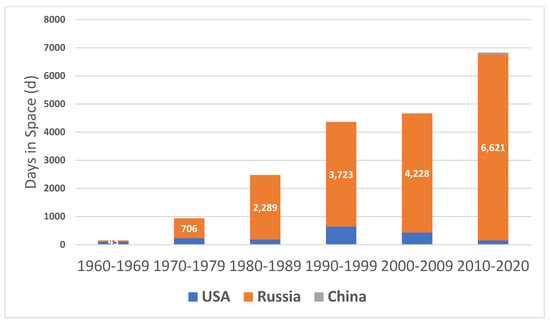
Figure 2.
Days in Space (d) per Decade and Nation.
In the early years of manned spaceflight, the X-15 was the first ever spacecraft (suborbital flights only) used in space (n = 3). Wostok (n = 8) and Woschod (n = 2) were the second and third spacecrafts for mankind to go to space in. In the 1960s, the Soyuz spacecraft era started with n = 6 missions, increasing to n = 40 flights from 2010 until the present. In the early years of manned spaceflight, the Mercury (n = 6), Gemini (n = 9) and Apollo (n = 6) spacecraft were used. From 1970–1979, primarily the Soyuz Spacecraft (n = 26) was used. In the 1980s, primarily the Space Shuttle (n = 32) and the Soyuz Spacecraft (n = 28) were used. In the 1990s, the number of space missions conducted with the Space Shuttle rose to the maximum of n = 64, while, in contrast, n = 21 missions were conducted with the Soyuz. In the 2000s, the Chinese Space Program started with n = 3 flights with Shenzhou. The Soyuz was used for n = 21 flights and the Space Shuttle was used for n = 32 flights. From 2010–2020, the Soyuz was almost the only vehicle used to travel to space, until SpaceX launched its vehicle for its first flight in 2020 and started a new era for the United States of America (Figure 3).
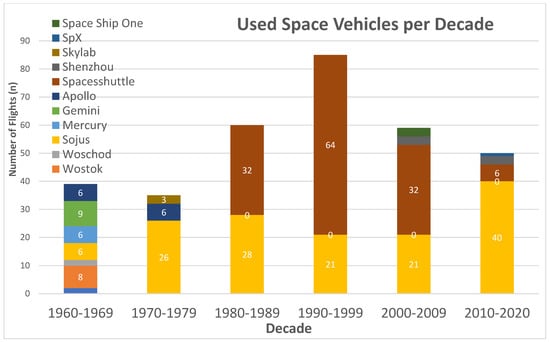
Figure 3.
Number of spacecrafts used to transport astronauts into space depending on the decade.
3.2. Incidents and Accidents of Manned Spaceflight
During n = 327 manned spaceflights from 1961 to 2020 (Table 1), n = 5 accidents and n = 36 incidents were reported, resulting in n = 5 fatalities and n = 3 total losses of a spacecraft (Table 2). In the study period, the number of incidents decreased from n = 8 in the 1960s and 1970s to n = 3 in the period from 2010 to the present. The number of accidents was at a maximum in the 1960s with two reported accidents and one accident for each decade of the 1970s, 1980s and 2000s. The 1986 Challenger accident and the 2003 Columbia accident (n = 7 deaths each) had the highest rates of fatalities during their decades. Altogether, n = 19 astronauts have died during spaceflight. The current statistical fatality rate is 0.058 deaths per spaceflight or 9.7 × 10−4 deaths per day in space with the highest fatality rate in the 1960s (0.013 deaths/day spent in space), and lowest rate in the 1990s and from 2010 until today (no deaths) (Figure 4). Since 2003, no astronaut fatality has been reported. Figure 5 shows death rate per day in space per decade.

Table 2.
Results of search string analysis concerning the number of manned spaceflight incidents and accidents.
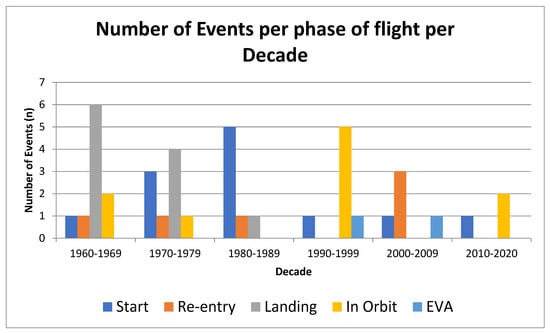
Figure 4.
Number of events per phase of flight per Decade.
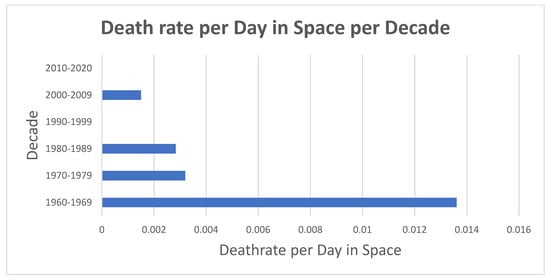
Figure 5.
Death rate per Day in Space.
3.3. Overall Rates of Incidents and Accidents
The overall incidence rate has constantly decreased from 0.22 incidents per mission/0.00086 incidents per day in space in the 1960s to 0.06 incidents per mission/0.000003 incidents/day in space in the 2010s (Figure 6).
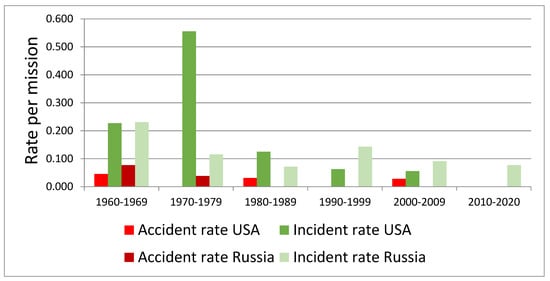
Figure 6.
Incident rates and accident rates permission for USA and Russia depending on decades.
The accident rate had its maximum in the 1980s (0.031 accidents per mission/0.000002 accidents per day in space/0.0001 deaths per day in space) and 2000s (0.028 accidents per mission/0.000002 accidents per day in space/0.00001 deaths per day in space) with the fatalities of the Space Shuttle (Figure 5).
3.4. Incidents and Accidents Per Phase of Flight
Our data (Figure 4) revealed that the most dangerous phase of flight is launch (defined as from the immediate time of ignition until reaching the Kármán line at an altitude of 100 km (62 mi)), landing (decoupling (if spacecraft was attached), and re-entry until safe de-boarding of crew members) and during a stay in orbit (defined as time in-between). Altogether, n = 12 incidents (incident rate per spaceflight: 0.04) and one accident (accident rate: 0.003) during launch have been reported, n = 9 incidents (incident rate: 0.03) and two accidents (accident rate: 0.006) during landing and n = 10 incidents (incident rate: 0.03) during a stay in orbit (Figure 7)
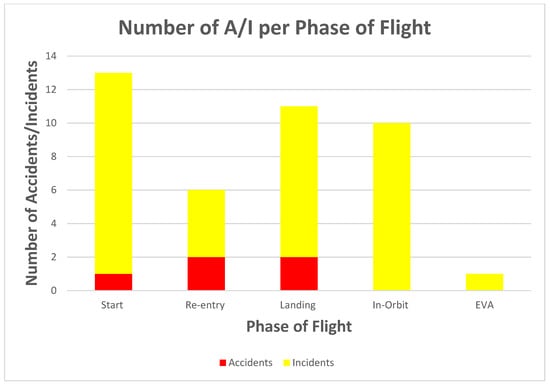
Figure 7.
Absolute number of Incidents and accidents per phase of flight.
4. Discussion
4.1. Manned Spaceflights
Spaceflights before 1960 were quite experimental and dangerous. Since Gagarin became the first human to travel into space and complete one orbit in 1961, the number of manned spaceflights has increased significantly over the past decades. There is now scientific data which summarizes incidents and accidents throughout the period since 1961, and provides a trendline of fatalities. In the study period from 1961 to 2020, our data revealed n = 327 manned space flights with an increase in the number of manned spaceflights and accumulating days spent in space over the past decades. An increasing number of missions, and increasing mission-duration time (days spent in space) are probably results of greater international cooperation. Although the number of used spacecrafts has constantly decreased, humanity has been able to place more astronauts in space, with associated longer mission-duration times in space. The Space Shuttle, operating from the 1970s to 2000s, had capacity for seven astronauts. With the shutdown of the Space Shuttle Program, the number of astronauts in space did not decrease. Although the Soyuz only has capacity for up to three crew members, the number of astronauts in space has continued to increase.
Human spaceflight has also been characterized by the people who become astronauts. There were and are differences between space agencies, in terms of astronaut demographics, particularly between NASA and ROSCOSMOS, with first-time NASA astronauts more likely to be women, civilian and older than first-time ROSCOSMOS cosmonauts [9]. In general, most accidents during the past 60 years were due to technical reasons, as extensive training of astronauts occurs prior to spaceflight.
4.2. Incidents and Accidents during Spaceflight
As of 2020, there have been 15 astronaut and 4 cosmonaut fatalities during spaceflight, but there have also been some non-astronaut fatalities during spaceflight-related activities. With an average fatality rate of 9.7 × 10−4/day, space flight has an 8.4-fold higher fatality risk than motorcycling and a 1300-fold higher fatality risk than air travel (Ford 2000).
Altogether, the most dangerous decades for human spaceflight were the early decades of the 1960s and 1970s; with the highest death rates (>0.01). There has been an overall decrease in incidents and accidents over the past 40 years. The incidence rate for the United States has constantly decreased (0.0045 accidents per mission 1960s to 0 in the 2010s). The fatalities associated with the Space Shuttle in the 1980s (0.031) and 2000s (0.028) marked the highest U.S. fatality rates.
The incidences concerning the Russian space program have also constantly decreased from 0.231 accidents per mission (1960s) to 0.077 (2010s). The accident rate showed two peaks, with an accident rate of 0.077 per mission in the 1960s and 0.038 in the 1970s. After one accident in 1971 (Soyuz 11, three fatalities), no Russian fatality has been reported. Since 1971, there has been no fatality during a space mission inside of a Soyuz, so Soyuz is considered one of the most reliable space ships nowadays.
Most incidents were reported during launch, landing and staying in orbit, but no accident was reported during a stay in orbit, so the fatality rate is similar to that concerning commercial airplane flights [10].
4.3. Health Issues during Spaceflight
An orbital spaceflight is a source of physiological and psychological distress for crewmembers, and the amount of effort required to adapt to a long-duration space mission may indeed increase dramatically [11]. Usually, for non-commercial spaceflights, the selection of the crewmembers is extensive, and only extremely healthy crewmembers are selected to travel to space. Since incidents and accidents related to human factors are always multi-dimensional [12], further research needs a multi-dimensional approach. As a first step, this article only summarizes technical aspects, in particular, to evaluate time-dependent phases of flights with a higher probability of possible harm to crewmembers.
5. Limitations
This study only summarizes public data bases. Internal data of national space agencies were not searched. This study collected retrospective data. Human spaceflight is characterized by extensive testing to minimize potential human and economic risks, but test flights and incidents and accidents of the surrounding people were excluded. In this study, only incidents and accidents during spaceflight were examined, as astronauts have also died while training for space missions, such as the Apollo 1 launch pad fire which marked the fatality of three crewmembers [13]. Autopsies showed that they had expired from asphyxiation, due to hypoxia and carbon monoxide, but also had third degree burns over 25–50% of their bodies [14].
6. Conclusions
Gathering all available data, human spaceflight has become safer from the 1960s until the present. Especially in reference to mission duration time (days spent in space), manned spaceflight has become significantly safer.
Author Contributions
J.H. and J.S. designed the study. Data collection and analysis was performed by J.H. and J.S. J.S. drafted the manuscript. M.K., T.R. and O.U. improved the manuscript by critically reviewing data and providing additional comments. All authors have read and agreed to the published version of the manuscript.
Funding
This study was sponsored by the German Society of Aerospace Medicine (DGLRM), the European Society of Aerospace Medicine (ESAM) Space Medicine Group and internal institutional funding.
Institutional Review Board Statement
Not applicable.
Informed Consent Statement
Not applicable.
Conflicts of Interest
The authors declare no conflict of interest.
Abbreviations
| CMO | Crew Medical Officer |
| ESA | European Space Agency |
| ISS | International Space Station |
| LEO | Low-earth Orbit |
| NASA | National Aeronautics and Space Administration |
| RCT | Randomized Controlled Trial |
References
- Menger, R.; Wolf, M.; Thakur, J.D.; Nanda, A.; Martino, A. Astronaut Michael Collins, Apollo 8, and the anterior cervical fusion that changed the history of human spaceflight. J. Neurosurg. Spine 2019, 31, 87–92. [Google Scholar] [CrossRef]
- Zeller, A.F. Human error in the seventies-reviewed and projected through the eighties. Aviat. Space Environ. Med. 1981, 52, 241–246. [Google Scholar]
- Doarn, C.R.; Polk, J.D.; Shepanek, M. Health challenges including behavioral problems in long-duration spaceflight. Neurol. India 2019, 67, S190–S195. [Google Scholar] [CrossRef] [PubMed]
- Suva, D.; Poizat, G. Shuttle Challenger disaster: What lessons can be learned for management of patients in the operating room? Rev. Med. Suisse 2015, 11, 367–370. [Google Scholar] [PubMed]
- Grey, J. Columbia-aftermath of a tragedy. Aerosp. Am. 2003, 41, 26–29. [Google Scholar]
- Luo, X.L. A classification on human factor accident/incident of China civil aviation in recent twelve years. Space Med. Med. Eng. 2004, 17, 318–321. [Google Scholar]
- Evans, M.E.; Graham, L.D. A Flexible Lunar Architecture for Exploration (FLARE) supporting NASA’s Artemis Program. Acta Astronaut. 2020, 177, 351–372. [Google Scholar] [CrossRef]
- Fairén, A.G.; Parro, V.; Schulze-Makuch, D.; Whyte, L. Searching for Life on Mars Before It Is Too Late. Astrobiology 2017, 17, 962–970. [Google Scholar] [CrossRef] [PubMed]
- Smith, M.G.; Kelley, M.; Basner, M. A brief history of spaceflight from 1961 to 2020: An analysis of missions and astronaut demographics. Acta Astronaut. 2020, 175, 290–299. [Google Scholar] [CrossRef] [PubMed]
- Boyd, D.D.; Stolzer, A. Accident-precipitating factors for crashes in turbine-powered general aviation aircraft. Accid. Anal. Prev. 2016, 86, 209–216. [Google Scholar] [CrossRef]
- Gatti, M.; Palumbo, R.; Di Domenico, A.; Mammarella, N. Affective health and countermeasures in long-duration space exploration. Heliyon 2022, 8, e09414. [Google Scholar] [CrossRef] [PubMed]
- Hupfeld, K.E.; Richmond, S.B.; McGregor, H.R.; Schwartz, D.L.; Luther, M.N.; Beltran, N.E.; Kofman, I.S.; De Dios, Y.E.; Riascos, R.F.; Wood, S.J.; et al. Longitudinal MRI-visible perivascular space (PVS) changes with long-duration spaceflight. Sci. Rep. 2022, 12, 7238. [Google Scholar] [CrossRef]
- Campbell, M.R. The Apollo 1 Fire. Aerosp. Med. Hum. Perform. 2017, 88, 71–72. [Google Scholar] [CrossRef]
- Apollo 204 Review Board Final Rep. NASA-TM-84099. Available online: https://history.nasa.gov/Apollo204/appendices/AppendixD12-17.pdf (accessed on 20 September 2022).
Publisher’s Note: MDPI stays neutral with regard to jurisdictional claims in published maps and institutional affiliations. |
© 2022 by the authors. Licensee MDPI, Basel, Switzerland. This article is an open access article distributed under the terms and conditions of the Creative Commons Attribution (CC BY) license (https://creativecommons.org/licenses/by/4.0/).